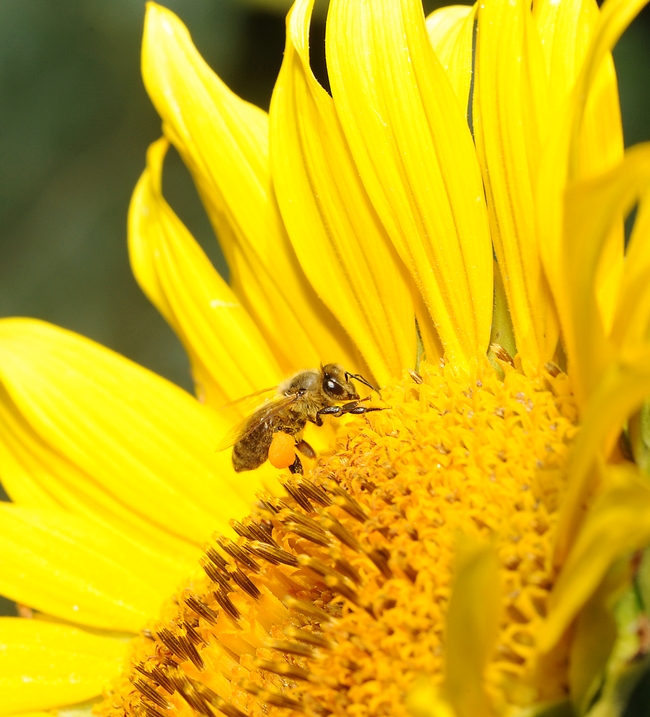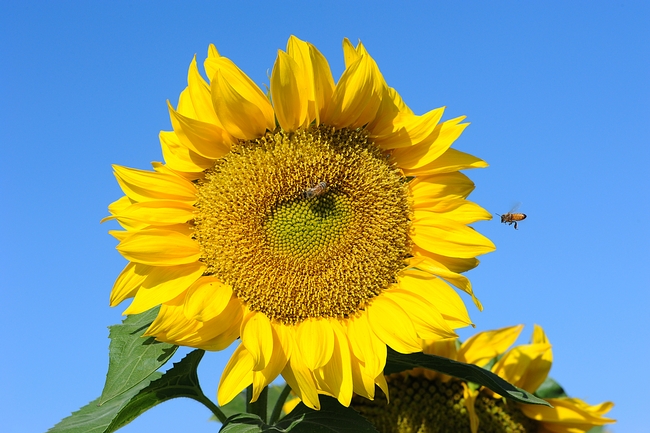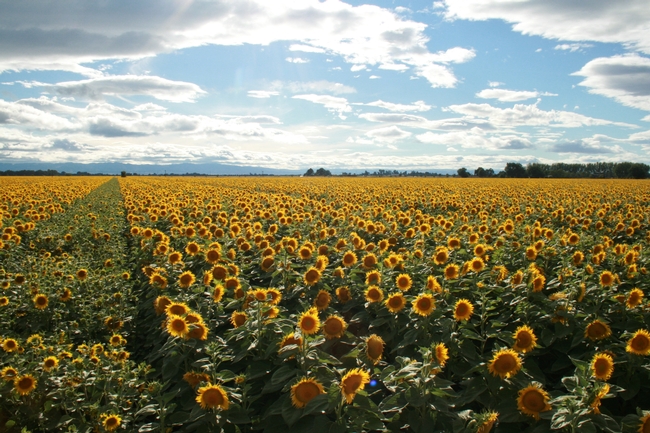UC Blogs
Peer reviewed website content at fruitsandnuts.ucdavis.edu
All of the new additions to the FNRIC website, fruitsandnuts.ucdavis.edu, would not be possible without the hard work of our expert reviewers. With...
Kumquats
The kumquat can be an attractive component of the winter garden with bright green foliage contrasted with multiple orange fruit. Given our recent cold snap, the kumquat is also one of the most frost tolerant citrus available.
Kumquats are evergreen shrubs or trees with dark, glossy, alternate, lanceolate green leaves and sweetly fragrant white blossoms. The fruit are small round or ovoid globes that appear in profusion throughout the tree. The peel is golden-yellow to reddish orange with large conspicuous oil glands; the pulp is segmented and generally contains seeds. Kumquats are slow growing and standard species planted in the garden will grow 8-14 ft. high whereas dwarf and container grown kumquats will reach approximately 6 ft. Kumquats are well adapted to container culture and make beautiful doorway or entry specimens.
Kumquats are native to south Asia and were originally cultivated in China, Japan and throughout southeast Asia. Robert Fortune, a collector for the London Horticultural Society introduced the kumquat to Europe in 1846. Kumquats were originally classified as Citrus japonica but were reclassified as the genus Fortunella in honor of Robert Fortune. The various kumquats are distinguished as species rather than cultivars. There are seven species of kumquats but only three are generally grown in the U.S. Several specialty varieties and hybrid crosses are available in northern California.
The most common species of kumquat grown in northern California are the Nagami kumquat (Fortunella margarita Swing.), the Meiwa kumquat (Fortunella crassiofolia Swing.) and the Fukushu kumquat (Fortunella obovata Swing.).
The Nagami or oval kumquat is the most commonly grown kumquat species in the U.S. and is hardy to 24 oF. It will survive temperatures down to 19 oF with loss of fruit. This species is thornless with heavy yields of ovoid or oblong fruit with 4 or 5 segments of pulp and 2 to 5 seeds. New fruit generally ripens in October to January but will store on the tree much longer. The peel is sweet and pulp sour; the fruit can be eaten if the peel and pulp are chewed together.
The Meiwa or round kumquat is less common in the U.S. and is hardy to 28 oF. The plant is dwarf, frequently thornless or with short, stout spines, and thick, partially folded leaves. The Meiwa yields short-oblong to round fruit with a thick, sweet peel and light orange pulp with relatively low acidity. The Meiwa is considered the best for eating fresh.
The Fukushu kumquat is also less common and although hardy to 28 oF cannot withstand lower temperatures. This species is distinguished by round rather than lanceolate leaves. The bright orange fruit is rounded or bell-shaped and has a thin peel; the pulp is also orange and slightly acidic. The Fukushu is also suitable for eating fresh.
Kumquats are susceptible to most citrus pests and diseases but are generally resistant to citrus canker. The most common pest of kumquats in the home garden are aphids, scale and whitefly; information on management of these pests is available at www.ipm.ucdavis.edu .
Kumquats, like most citrus, are shallow rooted and should be grown in soil with adequate drainage. Kumquats do well in containers. An ideal container should have at least a 15-gallon capacity; wine half-barrels make excellent containers. The container should have multiple holes for drainage and be raised with bricks, wood blocks or ceramic feet to allow adequate drainage and air circulation. Like any container grown plant, soil moisture should be checked often. Regular watering should maintain damp but not wet soil. Container grown kumquats should be fertilized regularly since the frequent watering required to maintain soil moisture will leach nutrients out of the soil.
Most kumquats ripen in late autumn through early winter. The fruit is generally fully colored, usually orange, when approaching ripeness. Taste testing individual fruit will let you know when the fruit are ripe. Since citrus fruit does not ripen well off the tree, kumquat fruit should be left on the tree until harvested. Tree-stored fruit will gradually become darker orange and somewhat sweeter over time.
Kumquats can be eaten fresh although they can be tart. For the adventurous, there is a video on you tube demonstrating how to eat a kumquat http://www.youtube.com/watch?v=GoLr7BieIKQ. Kumquats can be used to make preserves, marmalade and jelly. Thinly sliced kumquats can be used as a colorful garnish or to add zest to a salad.
Kumquats often used as a decoration for the Lunar New Year. Twigs bearing multiple fruit are used as table or gift decoration. Containerized kumquat trees often given as Lunar New Years gifts, especially in Vietnam where the fruit plays a special role in celebrations.
References:
Anzeno, V, March 2008 Citrus for the Home Garden UCANR Cooperative Extension, San Diego //ucanr.edu/blogs/slomggarden/blogfiles/4259.pdf
Ingels, C & McClure, J (eds) Growing Citrus in Sacramento UCANR Cooperative Extension Master Gardener – Garden Notes GN 127 http://ucanr.org/sites/sacmg/files/72239.pdf
Morton, J. 1987. Kumquat. p. 182–185. In: Fruits of warm climates.http://www.hort.purdue.edu/newcrop/morton/kumquat.html
Wikipedia, Kumquat http://en.wikipedia.org/wiki/Kumquat [accessed December 16, 2013.
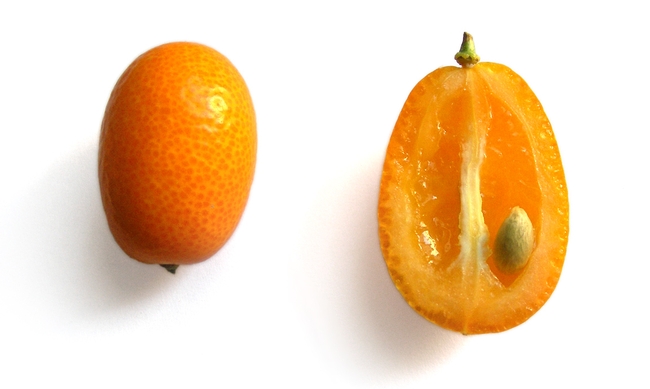
Kumquat fruit. (photo from Wikipedia.com)
Sunflower seeds are boosting California’s ag economy
Sunflower seeds are a healthy snack, a salad garnish, and a baseball dugout icon. But how much do you know about the state’s hybrid seed production that results in the global planting and growing of oil and confectionary-type sunflower seeds?
Do you know that the Sacramento Valley produces about 25 percent of the world’s hybrid planting sunflower seeds? We grow some 47,000 acres of this crop, valued at about $70 million (2012 County Crop Reports).
Even better news is that the hybrid sunflower seed production industry is growing, sparked by the demand for our high quality seed and the increased interest in sunflower oil worldwide. In 2007, for example, the value of California’s sunflower seed crop totaled $22 million on 27,000 acres. Fast forward to today and we see a 70 percent increase in acreage and more than a three-fold increase in value. Additionally, the industry reports millions of dollars in seed sales to markets around the world including the Midwestern states as well as the four largest producers of sunflower oil: Ukraine, Russia, European Union, and Argentina.
The sunflower (Helianthus annuus) is native to North America; the Native American Indians prized it as an important, high-energy food source. Indeed, sunflower oil is a healthy choice; it is light in taste, supplies more vitamin E than any other vegetable oil, and delivers low levels of saturated fat. Sunflower oil is also stable at high cooking temperatures, rendering it favorable to the food processing industry.
Production of hybrid sunflower seeds involves planting male and female (male sterile) lines in the same fields, usually alternating with six rows of females and two rows of males. Males generally possess multiple flowers on a stock, compared to the single composite female flower. Honey bees, usually two colonies per acre, move the pollen from the male to female lines. Native solitary bees (especially sunflower bees) are also important in sunflower seed production, not only because of their pollination but because their presence increases honey bee activity, causing greater dispersement between male and female lines.
After pollination, when the seeds are set, growers remove the male rows to prevent contamination with female rows. After the sunflower stocks naturally dry down, the hybrid planting seed is harvested with yields averaging 1,400 pounds per acre and 40-45 percent percent oil content, depending on the variety.
Compared to open pollinated varieties, hybrid planting seed from controlled crosses of male and female lines result in higher yields and oil content. The plants also display better disease resistance, a high degree of self-compatibility (reducing the need for bee cross-pollination), and more uniformity in height and moisture content at maturity, which facilitates harvest.
It’s crucial to maintain field isolation between different hybrid sunflower varieties so that the seed produced remains pure to the desired cross. As a result, growers plant different sunflower seed varieties at least 1-1/4 miles apart or they separate fields in time so that they bloom at different times in the season, thus preventing pollen drift. volunteer sunflowers from the previous year, wild sunflowers, and sunflower varieties blooming in backyard gardens pose risks to hybrid sunflower seed production. Roguing prior to bloom is important when nearby production fields are blooming.
Do you know that sunflower seed production has few pest or disease problems? Sunflower head moth, a native caterpillar pest, can attack the seed heads as well as occasional flocks of birds (starlings, blackbirds, and finches) triggering yield and quality losses.
As the result of industry and research efforts, along with our near perfect weather for seed production with hot, dry summers and cool nights, the Sacramento Valley is known throughout the world as a premier location for sunflower breeding, variety development, and seed production.
In the summertime, the brilliant golden colors turn fields in the Sacramento Valley into Vincent Van Gogh-like paintings. Sunflowers are also fun to watch because in the bud stage they track the movement of the sun across the horizon. Once the flower opens it faces east toward the morning sun, which may help prevent the sun-scalding of seeds.
So, whether you like to cook with sunflower oil, snack on sunflower seeds, use them as a salad garnish, or watch your favorite baseball players crack them between innings, sunflowers pack a major economic agricultural wallop that begins right here in the Sacramento Valley. Who knew? Now you do.
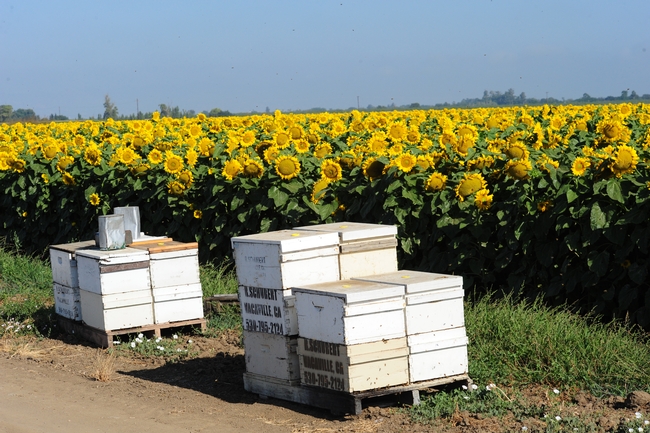
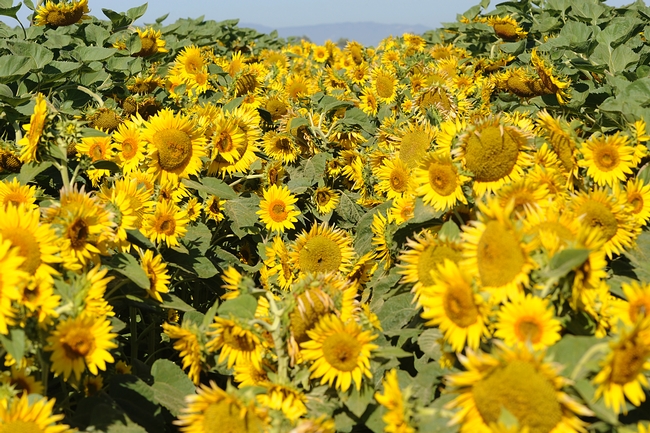
Bumble Bee Book: The Wait Is Over
If you've been itching for that long--awaited book about North America's bumble bees, the itch and the wait are over. You can now...
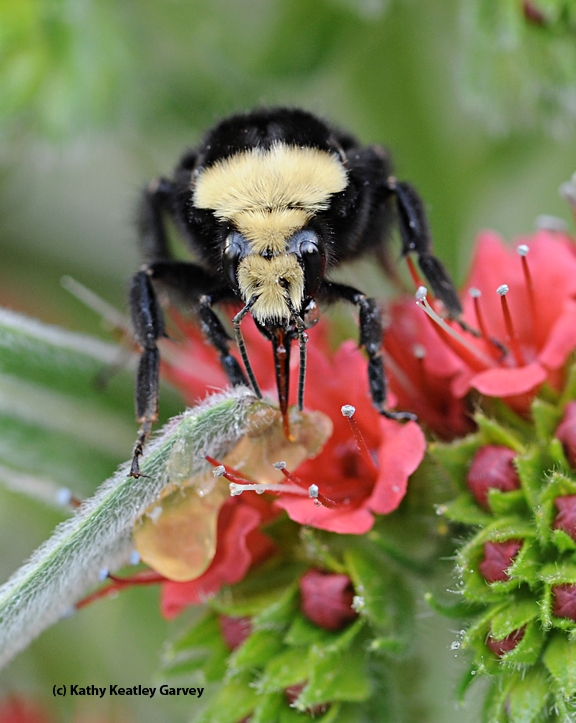
A yellow-faced bumble bee, Bombus vosnesenskii, on tower of jewels. (Photo by Kathy Keatley Garvey)
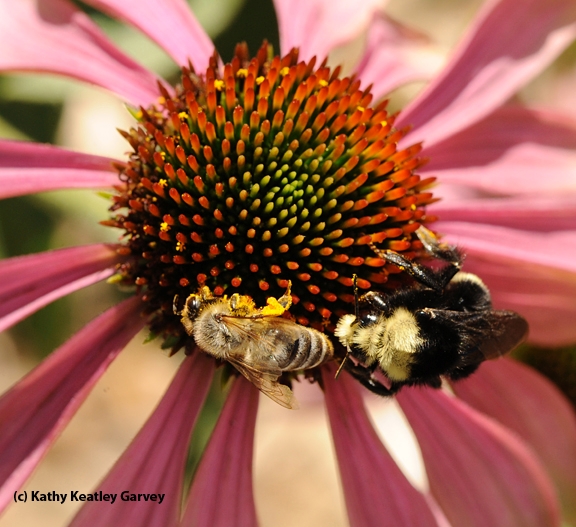
A honey bee and yellow-faced bumble bee sharing a coneflower. (Photo by Kathy Keatley Garvey)
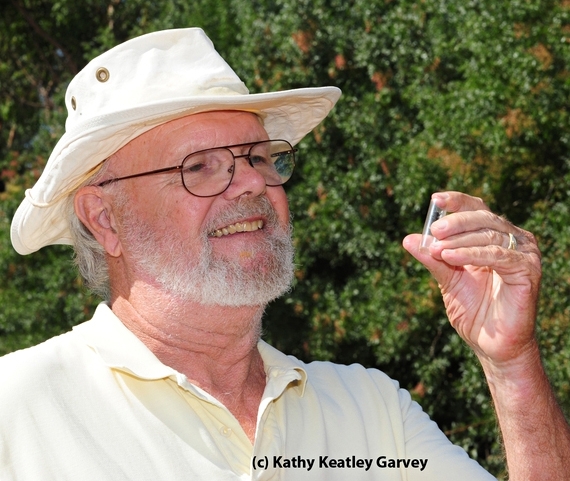
Native pollinator specialist Robbin Thorp, emeritus professor of entomology at UC Davis. (Photo by Kathy Keatley Garvey)
Time for a Spray of Sunshine
It's time for a spray of sunshine. The golden daisy bush (genus Euryops, family Asteraeae), will do that to you. The popular perennial both...
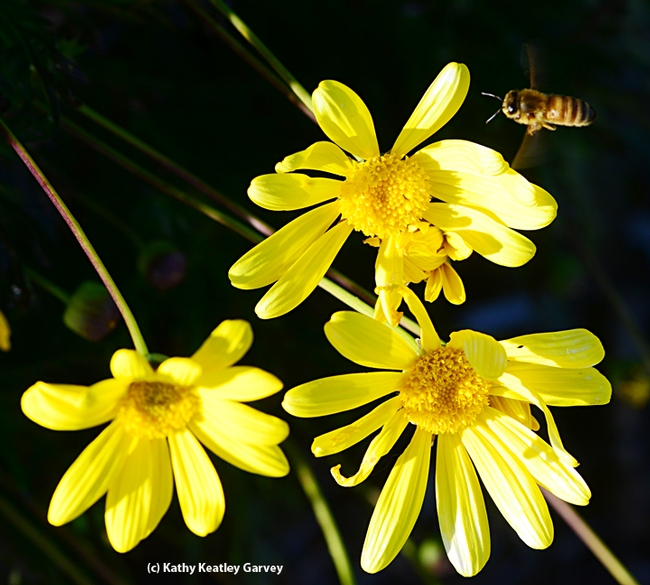
Honey bee heading for Euryops. (Photo by Kathy Keatley Garvey)
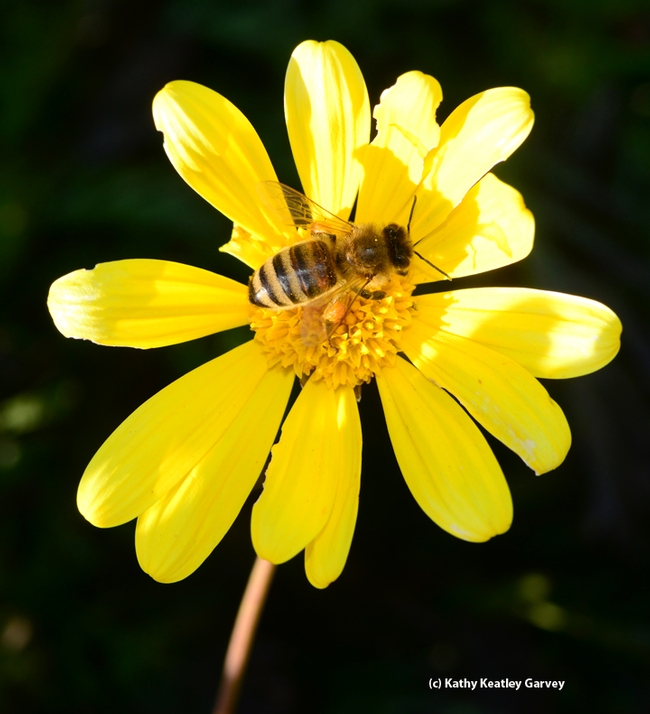
A perfect match: Euryops and a bee. (Photo by Kathy Keatley Garvey)


